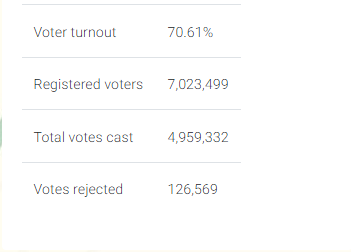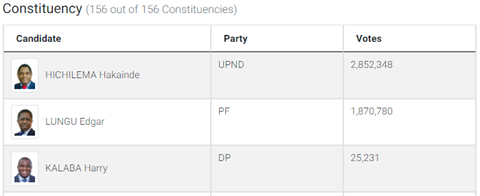2021 election results in maps and charts
By Mac Nzombola
- 8 minutes read - 1673 wordsZambians went to the polls to elect a president on August 12, 2021—they needed to re-elect the incumbent or choose a new one, along with new 156-member parliament (an additional 10 members are nominated by the president for a total of 166). Sixteen presidential candidates took part in the polls. The results reported by the Elections Council of Zambia (ECZ) show that the two leading presidential candidates, Hakainde Hichilema (HH), of the United Party for National Development (UPND) and Edgar Chagwa Lungu (ECL) of the Patriotic Front (PF) received 98% of the 4.8 million valid votes between them.

source: ECZ

source: ECZ
The other fourteen candidates combined, received the remaining 2% of the votes with the third placed candidate in the election receiving about 0.5%—this was a two-candidate race, and the results are discussed as such.
Countrywide view of presidential results
One common way election results are presented on maps is in a winner-take-all format. With the map divided into regions—156 constituencies in the case of the 2021 electoral map for Zambia—a solid color is assigned to each region corresponding to the party or candidate winning a plurality or majority in that region. This may suggest the winning candidate received 100% of the vote in any given region they won. Here are two examples of such maps for the 2011 and 2015 elections in Zambia, and below is another for 2021 election results.
Red represents the UPND and their candidate HH, green represents the PF and their candidate ECL. This winner-take-all map suggests a country split in two west-east regions. Granted, there are a few red HH areas in the east, and a few green ECL areas in the west around Lusaka and Kabwe, but the general picture is that of a country divided in halves. Some look at this map, a lot similar to the 2015 and 2016 results maps, and see Zambia divide along strict regional and ethnolinguistic lines: Control risk, for example.
However, hidden in the data underlaying the map are the gradations inherent in varying margins of victory or loss in each constituency for the candidates. A nuanced map that captures the gradual shift from the dominant wins to the marginal wins/losses to the total defeats of one candidate in regions across the map presents the colors of the regions as hues between the deep red of the UPND and the deep green of the PF; in between are the intermediate brown reds and brown greens of moderate victories or losses. With UPND data, deep green represents a loss greater than 80% i.e., UPND received less than 20% of the vote, and deep red represents a victory of greater than 80% for the UPND i.e., PF received less than 20% of the votes. Here is a map that accounts for the gradations:
As can be expected, using PF data gives the same picture because other parties, besides the UPND and the PF, and their candidates received such a minuscule number of votes that effectively valid votes that did not go to the UPND went to the PF, conversely votes that did not go the PF went to the UPND. The only clue that PF data underlays the second map is the legend where losses for the PF are represented by a deep red and wins by a deep green, opposite to the legend in the UPND data map above.
The 1 million vote margin of victory for HH has been widely reported: 2.8 million votes for HH to 1.8 million votes for ECL—it was landslide. The unseen part of the story in the reporting of the raw 1 million votes, and in a binary two-color map representing only the UPND and PF wins and losses that needs to be teased out from the data is that the votes for HH where not all from the western regions: the deep red areas on the map. Yes, voters in Dundumwezi constituency and many others in Southern province reprised their voting pattern from the 2016 elections, giving HH over 95% or more of their votes, and a lot of constituencies in Northwestern and Western provinces gave less but similar margins, highly notable are the 28 constituencies in the east that gave over 40% of their votes to HH. In 6 constituencies he received 48% to just shy of 50% of the votes, losing by fractions of a percent.
The one island of super PF support in the entire country, very much a deep green, is Sunday Chanda’s Kanchibiya constituency in Muchinga province where the PF won by 84%—no surprise here. Sunday Chanda was the PF’s media director prior to his nomination to run for the Kanchibiya seat. This is someone steeped in the arts of mass media and communication and perhaps sold himself and his party well.
Countrywide, HH won 68 of the 97 constituencies in his column by 60% or more of the votes; the same applies to 30 of the 59 constituencies that ECL won.
This means 40% to 49% of the people in 29 constituencies won by ECL, a lot of them in the east, voted to change government. Add to this detail the 7 constituencies the UPND MPs won in the east (see the parliamentary results map later).
The vote for change was much more pronounced and unanimous across the country than it appears from a simple red/green map. There is general agreement that the victory was a landslide, but it’s important to make clear that it was nationwide in nature rather than regional. The consensus opinion that Zambia is cleaved cleanly along ethnolinguistic lines at the ballot is not wholly accurate and should be delivered with necessary caveats.
Members of parliament for each constituency
That east and west in Zambia were essentially of one mind in the 2021 election is also plainly illustrated in the number of independent and UPND seats in the east as seen on the parliamentary results map, especially in the eastern province.
More than any other province, the eastern province voted for a hodgepodge of independents, incumbent party PF candidates and opposition party UPND candidates 1. (Kaumbwe constituency is yet to have an election for a member of parliament.)
Not entirely thrilled with the UPND and HH and not quite done with the PF and ECL they threw in a good number of independent candidates—these were, in most cases, people whose candidacy were in themselves protest candidatures against the PF for adopting other people to stand for these seats on the PF ticket. Adopting unpopular candidates in some constituencies was one of the major critique leveled at PF bosses in the PF postmortem after the election loss.
Of the three provinces in the northeast, Northern and Luapula voted for at least two or more UPND or independent members of parliament; Muchinga went solid green although Isoka and Nakonde constituencies gave the PF just over 50%—effectively a hung jury on the verdict, not an outright endorsement of the PF and its policies for another five years.
In the middle-north of the country along the line of rail, part of the commercial corridor of Zambia, Central, Copperbelt and Lusaka provinces shared their constituencies among the UPND, PF and independent candidates. Central province can be said to have a double identity as it straddles the two national regions with about two-thirds of it in the western Zambia, and about one-third of it in the eastern Zambia. It mirrors the nation in the appearance of two-region nature. But in a similar way to the country, its eastern constituencies only went marginally for the PF or UPND.
All the constituencies in Western province voted for UPND MPs except for Nalolo constituency which voted for Imanga Wamunyima of the Party for National Unity and Progress (PNUP). This island of yellow among red constituencies is an odd result. Crosschecking with the presidential results map shows HH won the seat by 83%. And from the ECZ reported number of candidates competing and getting votes for the Nalolo seat, it appears the UPND did not field a candidate which explains the presidential candidate receiving 83% of the vote but his party still seeming to lose the seat. Nalolo constituency is the only seat that went to another party besides the UPND in all of the Northwestern, Western and Southern provinces’ constituencies.
Revisiting the national map of the presidential results: we have four provinces with all their constituencies voting for either HH (3) or ECL (1)—sending that troubling signal of a nation divided. Drilling down in the results data, however, shows Zambians much more in agreement to go in a new direction than might appear from a cursory glance at the map. We are united in our goal for a better nation that works for everyone.
-
According to ECZ, the National Assembly election for Kaumbwe Constituency is yet to be conducted and is not listed in thier reported data.
↩︎